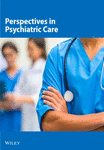Associations Among Emotional Intelligence, Resilience, and Humanistic Caring Ability in Nursing Postgraduates: A Response Surface Analysis and Moderated Mediation Model
Abstract
Purpose: This study aimed to explore the associations among the type of master program in nursing, emotional intelligence (EI), resilience, and humanistic caring ability (HCA), thereby providing a reference for cultivating HCA in Chinese nursing postgraduates.
Design and Methods: A multicenter cross-sectional study was conducted from February 22 to March 23, 2022, in four universities with Schools of Nursing across Eastern and Central China, recruiting a total of 189 nursing postgraduates. The questionnaire included the following instruments: the sociodemographic information questionnaire, the Wong and Law Emotional Intelligence Scale (WLEIS), the 10-item Connor–Davidson Resilience Scale (CD-RISC-10), and the Caring Ability Inventory (CAI). Correlation, response surface, and moderated mediation analyses were conducted to explore the associations among the variables of interest.
Findings: The results of correlation analysis and response surface analysis revealed significant positive associations of EI and resilience with HCA. The results of moderated mediation analysis indicated that resilience partially mediated the association of EI with HCA in nursing postgraduate students. The interaction effect between the type of master program and EI was significant in the association of EI with resilience.
Practice Implications: The findings of this research offered crucial insights for nursing educators on the associations among EI, resilience, and HCA and may provide important evidence for future interventional studies on promoting HCA in Chinese nursing postgraduates.
Trial Registration: Chinese Clinical Trial Registry identifier: ChiCTR2000038693
1. Introduction
Emotional intelligence (EI), resilience, and humanistic caring ability (HCA) are essential factors in nursing practice [1–4]. EI enables nurses to effectively respond to daily stress and demands [2], while resilience helps them cope with adversities and challenges [5–8]. HCA is a cornerstone of nursing, embodying the ability to deliver personalized, comprehensive, and humanistic care that meets patients’ psychological, physiological, social, and cultural needs [3, 9]. Additionally, the education level of nursing staff has a significant impact on patient prognosis [10, 11]. When the number of nurses who have received high-level training increases, the mortality rate of patients decreases [10]. In the nursing profession, master’s education is considered a prerequisite for advanced practice and education [12], and it also serves as a pathway to becoming an Advanced Practice Nurse (APN) [13], fostering the development of highly skilled nursing professionals. There were two kinds of master programs in nursing in mainland China: Master of Science (MS) programs which focus on research training and Master of Nursing Specialist (MNS) programs which emphasize advanced clinical practice [14].
Although previous research has identified positive associations between EI and HCA among nursing students [15, 16], the associations among EI, resilience, and HCA in the context of postgraduate nursing education remain largely unexplored, particularly within the differing MS and MNS programs in China. This research gap in nursing postgraduates warrants further investigation, as nursing postgraduates play a crucial role in providing high-quality care and addressing complex healthcare challenges.
It is important for nursing educators to comprehend the psychological factors of HCA and to develop tailored training programs for nursing postgraduate students. The present study aimed to explore the associations among EI, resilience, and HCA in nursing postgraduates and examine the role of the type of master program (MS and MNS) in the associations.
2. Methods
2.1. Study Design and Participants
We conducted a multicenter cross-sectional survey in four universities with Schools of Nursing in China, spanning from Central to Eastern China, including Henan, Hunan, and Guangdong provinces, from 22 February to 23 March 2022. The inclusion criteria included (a) students currently enrolled as full-time nursing postgraduates and (b) those who were willing to participate and capable of completing the questionnaires. Students diagnosed with mental disorders, such as anxiety or depression, were excluded from this study.
2.2. Sample Size
We employed the R “pwr” package to estimate the minimum sample size necessary for detecting a significant moderated mediation effect. With the assumptions of a mediation effect of 0.3, a 0.5 relationship between the moderator and dependent variable, a 0.4 relationship between the mediator and dependent variable, an alpha level of 0.05, and a power of 0.80, we ascertained that at least 174 participants were required for the study [17, 18].
2.3. Procedures and Data Collection
Eligible participants were approached and provided with an introduction page to the study. Upon obtaining their consent form, participants were asked to complete either a paper-based or online questionnaire survey. Their participation was confirmed to be voluntary and anonymous, and their decision to participate or not would not have any impact on their academic performance. After excluding 11 invalid questionnaires (e.g., incomplete responses, inconsistent answers, and patterned responses), a total of 189 (94.5%) usable questionnaires were analyzed in the current study.
2.4. Ethics Statement
The present study is part of the Be Resilient to Nursing Career program and was approved by the Ethics Committee of the First Affiliated Hospital of Guangzhou University of Traditional Chinese Medicine (ZYYEC-ERK [2020] 132). Participants allowed us to use their data for academic research and publication. All participants provided informed consent, and the study was conducted in accordance with the Declaration of Helsinki.
2.5. Measurements
2.5.1. Sociodemographic Characteristics
The sociodemographic survey encompassed age, gender, grade, type of college and master program, homeplace, monthly household income, whether the participants were an only child or not, experience as a student leader, and experience working as a nurse.
2.5.2. EI
The Chinese version of the Wong and Law Emotional Intelligence Scale (WLEIS) was used to assess the level of EI of participants, with a Cronbach’s α of 0.86 in Chinese university students [19, 20]. This scale includes a total of 16 items which were divided into four dimensions: self-emotion appraisal (SEA), regulation of emotion (ROE), use of emotion (UOE), and others’ emotion appraisal (OEA). Items were rated on a 7-point Likert scale (1 = strongly disagree, 7 = strongly agree), with total scores ranging from 16 to 112. Higher scores indicate higher EI. Cronbach’s α of WLEIS in the present study was 0.93.
2.5.3. Resilience
The Chinese version of the 10-item Connor–Davidson resilience scale (CD-RISC) was used to measure the resilience level of participants, with a Cronbach’s α of 0.91, a test-retest reliability of 0.90, and a content validity index of 0.89 [21]. The items of this scale were on a 5-point Likert scale (0 = never to 4 = almost always). The total scores ranged from 0 to 40, with higher scores indicating higher resilience levels. Cronbach’s α of 10-item CD-RISC in this study was 0.90.
2.5.4. Humanistic Caring Ability
The Chinese version of the CAI was employed to assess the level of caring ability, with a total Cronbach’s α of 0.75, a test-retest reliability of 0.75, and a content validity index of 0.80 among Chinese nursing undergraduates [22]. The CAI, which used the Likert 7-level scoring method (1 = strongly disagree to 7 = strongly agree), consisted of 37 items and three dimensions: knowing (14 items), courage (13 items), and patience (10 items). The total score of CAI ranged from 37 to 259 (knowing: 14 to 98, courage: 13 to 91, and patience: 10 to 70), with higher scores indicating better HCA. Cronbach’s α of CAI in the current study was 0.86.
2.6. Data Analysis
Firstly, the demographic characteristics of the respondents were assessed by frequency, percentage, mean, and standard deviation (SD). The t-test and ANOVA were employed to compare the mean score of HCA by demographic characteristics of respondents. Before performing Pearson correlation analysis among EI, resilience, and HCA, the skewness and kurtosis test was used to evaluate the normal distribution characteristics of these variables.
Secondly, response surface analysis (RSA) was conducted to estimate the congruent and discrepant impacts of EI and resilience on HCA. This analysis consisted of five factors: resilience, EI, resilience ∗ resilience, resilience ∗ EI, and EI ∗ EI.
Thirdly, Harman’s one-factor model was used to explore the potential existence of the common method variance (CMV). After that, the mediator effect of resilience was explored on the correlation between EI and HCA by the PROCESS macro (Model 4) of SPSS, adjusting for sociodemographic characteristics.
Fourthly, a moderation analysis was performed to explore the moderating role of the type of master program in nursing on the associations among EI, resilience, and HCA via PROCESS macro (Models 5, 7, and 14) of SPSS, adjusting for sociodemographic characteristics. All data analysis was performed with the aid of IBM SPSS 28.0 (IBM Corp., Armonk, NY, USA) and R 3.3.2.
3. Results
3.1. Participants’ Characteristics and Normality Test
Table 1 shows that the study included 189 nursing postgraduates, with a mean age of 24.28 years (SD = 2.14). 92.6% were female, 52.95% studied at traditional Chinese medicine schools, 71.4% were pursuing a MS in Nursing degree, 69.3% were in their first year, 58.2% were from rural areas, 56.6% had an income greater than 4000 Chinese Yuan, 30.2% used to work as a nurse, 69.8% had experience as a student leader, and 73.5% were the only child in their family. The mean scores of EI, resilience, and HCA were 66.70 ± 12.84, 24.30 ± 5.54, and 182.86 ± 17.70, respectively. T-test and ANOVA indicated that there was no considerable variation in the HCA based on the demographic characteristics of the participants. Table 2 shows that the distributions of all three variables (EI, resilience, and HCA) conformed to a normal or near-normal distribution [23].
| Variables | Mean ± SD (HCA) | N (%)/mean ± SD | p |
|---|---|---|---|
| Sex | 0.912 | ||
| Male | 182.36 ± 14.34 | 14 (7.4) | |
| Female | 182.90 ± 17.97 | 175 (92.6) | |
| Age, years | 182.86 ± 17.70 | 24.28 ± 2.14 | |
| Type of school | 0.336 | ||
| Western medicine school | 184.18 ± 18.15 | 89 (47.1) | |
| Chinese medicine school | 181.69 ± 17.29 | 100 (52.9) | |
| Type of master program | 0.517 | ||
| Master of Nursing Specialist | 182.33 ± 18.04 | 135 (71.4) | |
| Master of Science | 184.19 ± 16.92 | 54 (28.6) | |
| Grade | 0.245 | ||
| Year 1 | 184.18 ± 18.27 | 131 (69.3) | |
| Year 2 | 179.26 ± 15.60 | 50 (26.5) | |
| Year 3 | 183.75 ± 19.57 | 8 (4.2) | |
| Place of residence | 0.534 | ||
| Rural area | 182.18 ± 16.94 | 110 (58.2) | |
| Urban area | 183.81 ± 18.77 | 79 (41.8) | |
| Monthly household income, CNY | 0.553 | ||
| ≤ 4000 | 181.99 ± 17.53 | 82 (43.4) | |
| > 4000 | 183.53 ± 17.88 | 107 (56.6) | |
| Only child | 0.311 | ||
| Yes | 180.68 ± 17.29 | 50 (26.5) | |
| No | 183.65 ± 17.84 | 139 (73.5) | |
| Student leaders | 0.220 | ||
| Yes | 183.90 ± 17.86 | 132 (69.8) | |
| No | 180.46 ± 17.23 | 57 (30.2) | |
| Work experience | 0.781 | ||
| Yes | 182.32 ± 15.45 | 57 (30.2) | |
| No | 183.10 ± 18.64 | 132 (69.8) | |
| Resilience | 182.86 ± 17.70 | 24.30 ± 5.54 | |
| EI | 182.86 ± 17.70 | 66.70 ± 12.84 |
- Note: CNY, Chinese Yuan.
- Abbreviations: EI, emotional intelligence; HCA, humanistic caring ability; SD, standard deviation.
| Mean | SD | Skewness | Kurtosis | |||
|---|---|---|---|---|---|---|
| Statistic | SE | Statistic | SE | |||
| EI | 66.70 | 12.84 | −0.26 | 0.18 | 0.28 | 0.35 |
| Resilience | 24.30 | 5.54 | −0.17 | 0.18 | 0.59 | 0.35 |
| HCA | 182.86 | 17.70 | 0.30 | 0.18 | 0.12 | 0.35 |
| Knowing | 72.22 | 8.98 | 0.07 | 0.18 | −0.23 | 0.35 |
| Courage | 54.83 | 7.77 | 0.09 | 0.18 | 0.66 | 0.35 |
| Patience | 55.81 | 5.37 | −0.38 | 0.18 | −0.19 | 0.35 |
- Abbreviations: EI, emotional intelligence; HCA, humanistic caring ability; SD, standard deviation; SE, standard error.
3.2. Results of Correlation Analysis and Response Surface Analysis
Figure 1(a) shows that EI (r = 0.57, p < 0.001) and resilience (r = 0.58, p < 0.001) were moderately correlated with HCA. The results of the RSA are shown in Figure 1(b). As the figure shows, the score of HCA in the upper left corner in the back (high EI and high resilience) was considerably higher than the score in the upper left corner in front (high resilience and low EI) and the upper right corner in the back (low resilience and high EI). These results indicated that the total positive effect of EI and resilience on HCA was higher than their individual effects. Furthermore, the score of HCA in the upper left corner in front (high resilience and low EI) was considerably higher in contrast to the upper right corner in the back (low resilience and high EI), indicating that resilience exhibited a more positive impact on HCA than EI.
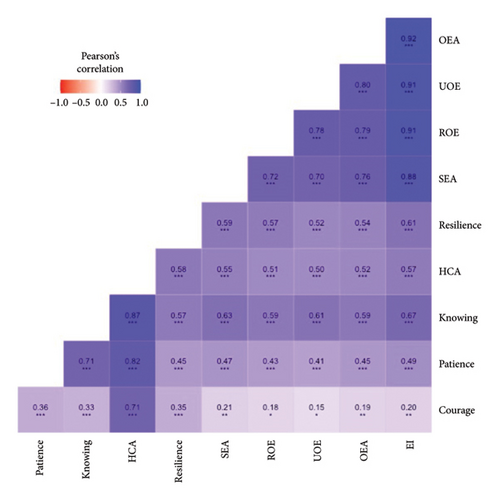
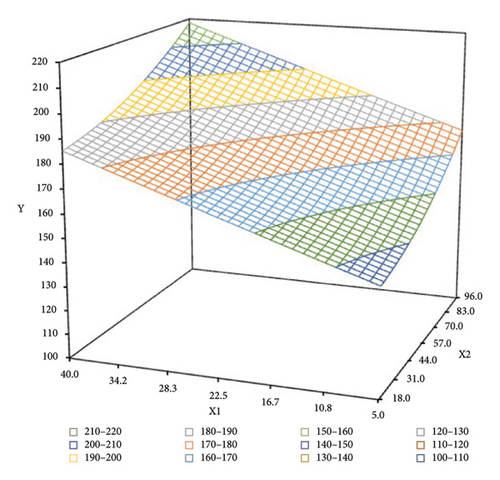
3.3. Mediating Effect of Resilience
The first factor explained 25.1% of the variance, which did not reach the threshold of 50%. This suggested that the influence of common method bias on the results was negligible [24]. Figure 2 shows that EI played a predictive role for the HCA (B = 0.478, p < 0.001, Figure 2(a)), and resilience exhibited a positive impact on HCA in nursing postgraduates (B = 1.182, p < 0.001, Figure 2(a)). Resilience partially mediated the association of EI with HCA. The indirect effect of EI through resilience on HCA was significant (B = 0.311, BootSE = 0.075, 95% CI: 0.169∼0.470, Figure 2(b)), including knowing (B = 0.114, BootSE = 0.035, 95% CI: 0.0481∼0.183, Figure 2(b)) and patience (B = 0.061, BootSE = 0.024, 95% CI: 0.0162∼0.108, Figure 2(b)).
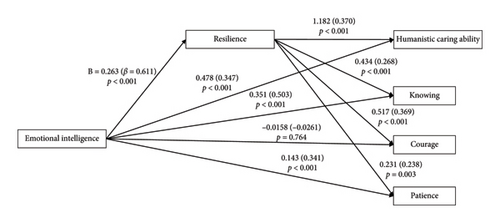

3.4. Moderating Effect of the Type of Master Program in the Association Between EI and Resilience
Figure 3 shows the outcomes of the moderation analysis. In Model 2 (EI ⟶ resilience), the significant moderation effect of the type of master program was observed (B = 0.126, 95% CI: 0.004 ∼ 0.248, p = 0.043, Figure 3(b)) and visualized in the simple slope test (βMNS = 0.238, p < 0.001; βMS = 0.364, p < 0.001, Figure 3(d)). In Model 1 (EI ⟶ HCA) and Model 3 (resilience ⟶ HCA), the interactions of the type of master program with EI (B = 0.195, 95% CI: −0.191∼0.580, p = 0.321, Figure 3(a)) and resilience (B = −0.221, 95% CI: −1.023∼0.580, p = 0.586, Figure 3(c)) were not significant.
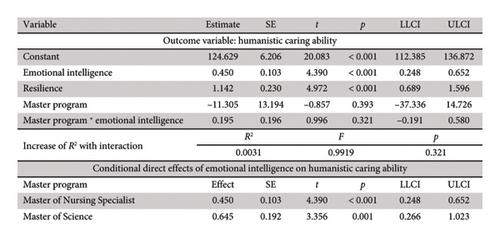
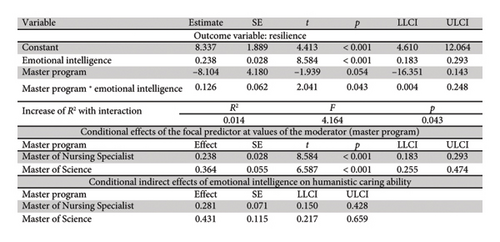
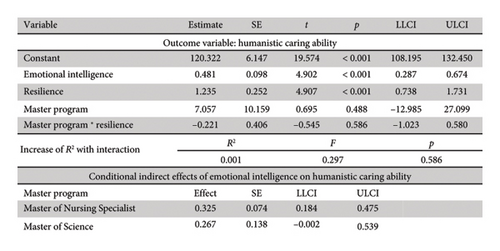
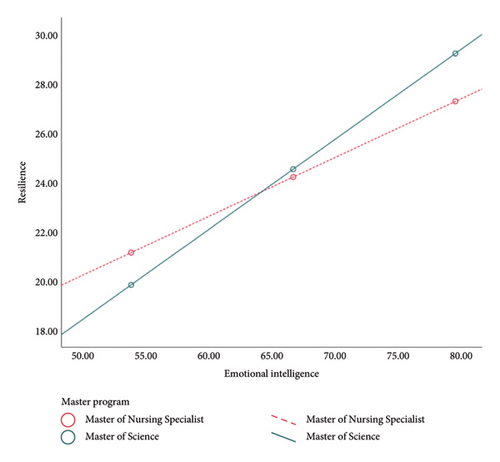
4. Discussion
The results of the current study emphasized the positive associations among EI, resilience, and HCA, with resilience partially mediating the association between EI and HCA. Additionally, the type of master’s program in nursing played a moderated role in the association of EI with resilience.
Firstly, we found that the HCA score of nursing postgraduates was relatively low (182.86 ± 17.70). The HCA score in the present study was higher than that of undergraduate students in China [15], but much lower than that of nursing students in the United States [25]. The low HCA score in Chinese nursing postgraduates may be attributed to the relatively lower proportion of humanities courses in China compared to Western medical schools, and the courses were more theoretical, lacking flexibility and diversity [26]. Additionally, it may be related to the implicit expression in Chinese traditional culture. Care in Chinese traditional culture usually occurs under the premise of close relationships, which may limit the development of HCA in Chinese nursing students [24, 25]. The development of HCA is a gradual process, influenced more by an individual’s life and working experiences than their level of education [27]. Therefore, it cannot be simply assumed that the level of education can directly impact the level of HCA in nursing professional students.
Secondly, EI was moderately associated with resilience and HCA in nursing postgraduates. This finding was in line with the previous research [28, 29]. EI could facilitate the transformation of nursing staff’s emotions into humanistic care for patients and their carers [26], and nursing students with high EI were also more likely to adjust their emotional responses in adverse situations and recover more quickly [30]. Nursing educators are recommended to employ specific pedagogical approaches to activate, engage, and address the emotional needs of nursing students [31, 32]. Currently, several effective training programs are available to improve EI. These programs typically consist of 4–16 sessions delivered through various methods such as lectures, role plays, case studies, and group discussions [33–37], which have the potential to be adapted and implemented for Chinese nursing postgraduates.
Thirdly, there was a positive association between resilience and HCA, which was in line with prior research focusing on Chinese midwifery students [38]. Nursing students with higher resilience may possess superior communication and problem-solving skills, allowing them to resolve issues quickly and pay closer attention to patients’ needs and feelings [29, 39], which may contribute to the development of HCA. However, a study conducted by Kim et al. reported no significant relationship between resilience and HCA [40]. The association between resilience and HCA warrants further research for confirmation.
Fourthly, the mediation model revealed that resilience remarkably acted as a partial mediator in the relationship between EI and HCA. As per the pathway of EI ⟶ resilience ⟶ HCA, it is crucial to develop strategies aimed at enhancing resilience among nursing postgraduates as a means to improve their HCA. Reyes et al. introduced the “Pushing Through” model, specifically addressing resilience among nursing students by illustrating the process of overcoming challenges and proactively working toward achieving goals [41]. Based on the model, the strategies for support, education, and reflection to increase the resilience of nursing students were identified [42]. These pedagogical approaches may be equally applicable to the educational setting in China.
Finally, the type of master’s program was confirmed as a moderator between EI and resilience. Compared to MNS students, the association of EI with resilience was stronger in MS students. The moderation effect could be attributed to the emphasis of the MNS program on clinical nursing practice, making MNS students more prone to experiencing burnout events that can negatively impact resilience, which may weaken the positive effect of EI on resilience [43, 44].
4.1. Limitations
Firstly, the study sample consisted of Chinese nursing postgraduates from three provinces, and the sample size was relatively small; whether our results could be generalized to other settings is uncertain. Secondly, causal relationships cannot be inferred due to the cross-sectional study design. Thirdly, the distribution of gender in this research was unbalanced, which introduces the potential for statistical bias between males and females.
5. Conclusion
Our study revealed that Chinese nursing postgraduates had poor HCA, and there was a positive association of EI and resilience with HCA. Resilience played a partially mediating role in the association between EI and HCA. Additionally, the type of master program in nursing was found to significantly moderate the association between EI and resilience. The findings offered crucial insights for nursing educators on the associations among EI, resilience, and HCA and may provide important evidence for future interventional studies on promoting HCA in Chinese nursing postgraduates.
Disclosure
A preprint of this manuscript was previously published on Research Square on July 10, 2023, with the same title and authorship as the manuscript [45].
Conflicts of Interest
The authors declare no conflicts of interest.
Author Contributions
Jinzhou Yu contributed to the conceptualization, data curation, methodology, and writing of the original draft. Xiaoxiao Mei contributed to the investigation, methodology, software, review, and validation. Yihao Zeng contributed to the investigation and data collection. Ding Yuan contributed to the investigation and provision of resources. Yanwu Yu contributed to resources management, supervision, and review. Zengjie Ye contributed to supervising the project, managing the resources, and reviewing the manuscript. Jinzhou Yu and Xiaoxiao Mei have contributed equally to this work.
Funding
This research was funded by grants from the National Natural Science Foundation of China (nos. 72274043 and 71904033).
Acknowledgments
The authors would like to thank all the nursing postgraduates for completing surveys and supporting data collection.
Open Research
Data Availability Statement
The data that support the findings of this study are available from the corresponding authors upon reasonable request.



